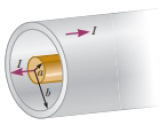
Concept explainers
Review. The use of superconductors has been proposed for power transmission lines. A single coaxial cable (Fig. P31.47) could carry a power of 1.00 × 103 MW (the output of a large power plant) at 200 kV, DC, over a distance of 1.00 × 103 km without loss. An inner wire of radius a = 2.00 cm, made from the superconductor Nb3Sn, carries the current I in one direction. A surrounding superconducting cylinder of radius b = 5.00 cm would carry the return current I. In such a system, what is the magnetic field (a) at the surface of the inner conductor and (b) at the inner surface of the outer conductor? (c) How much energy would he stored in the magnetic field in the space between the conductors in a 1.00 × 103 km superconducting line? (d) What is the pressure exerted on the outer conductor due to the current in the inner conductor?
Figure P31.47

(a)
Answer to Problem 47AP
Explanation of Solution
Given info: The power carry by the coaxial cable is
Formula to calculate the current flow in the coaxial cable is,
Here,
Substitute
Thus, the current flow in the coaxial cable is
Formula to calculate the magnetic field at inner conductor from Ampere’s law is,
Here,
Substitute
Conclusion:
Therefore, the magnetic field at the surface of the inner conductor is
(b)
Answer to Problem 47AP
Explanation of Solution
Given info: The power carry by the coaxial cable is
Formula to calculate the magnetic field at inner surface of outer conductor from Ampere’s law is,
Here,
Substitute
Conclusion:
Therefore, the magnetic field at the surface of the inner conductor is
(c)
Answer to Problem 47AP
Explanation of Solution
Given info: The power carry by the coaxial cable is
Formula to calculate the energy density store in magnetic field is,
Formula to calculate the total energy stored in the magnetic field in the space between the conductors is,
Here,
Write the expression for the small arbitrary volume.
Here,
Formula to calculate the magnetic field from Ampere’s law is,
Substitute
Integrate the above equation within limits.
Substitute
Conclusion:
Therefore, the energy that stored in the magnetic field in the space between the conductors is
(d)
Answer to Problem 47AP
Explanation of Solution
Given info: The power carry by the coaxial cable is
The magnetic field created by the inner conductor exerts a force of repulsion on the current in the outer sheath. The strength of this magnetic field is calculated in part (b) that is
Write the expression for the projection area of the outer conductor.
Write the expression for the circumferential area of the outer conductor.
Formula to calculate the current flow in the outer cylinder is,
Here,
Substitute
Substitute
Formula to calculate the force experience by the outer conductor is,
Formula to calculate the pressure exerted on the conductor due to the current is,
Substitute
Substitute
Conclusion:
Therefore, the pressure exerted on the conductor due to the current in the inner conductor is
Want to see more full solutions like this?
Chapter 31 Solutions
PHYSICS FOR SCI & ENGR W WEBASSIGN
- Solve and answer the question correctly please. Thank you!!arrow_forwardr 2. Measuring Length mm 1 cm 2 3 INCH 1 16THS 5 6 7 8 9 10 11 FAIRGATE COLD SPRING, NEW YORK 2 3 12 1. Using the metric (top) scale only, what units are being used for the long lines with the numbers? Hint: Remember that 2.54 cm = 1 in. 2. What are the units of the small lines? 3. How many decimal places should be recorded using this tool? 4. What is the length of the red line? Note: Make sure to use the correct units and decimal places. 5. Now observe your ruler. What metric units are used on your ruler? 6. How many decimal places should you record when using your ruler? 7. Measure a box, book, coin and can and fill out the data table below. Make sure to use units and the correct number of decimal places for your ruler. Table 1: Measuring Length Data Table Object Length of the box Length Local PR Distribution Only $99/Release. Get Started On Our Website Now! V 2 217arrow_forwardPROBLEM 3 Cables A and B are Supporting a 185-lb wooden crate. What is the magnitude of the tension force in each cable? A 20° 35° 185 lbsarrow_forward
- No chatgpt plsarrow_forwardhelp me with the experimental set up for the excel i did. the grapharrow_forwardWhich of the following best describes how to calculate the average acceleration of any object? Average acceleration is always halfway between the initial acceleration of an object and its final acceleration. Average acceleration is always equal to the change in velocity of an object divided by the time interval. Average acceleration is always equal to the displacement of an object divided by the time interval. Average acceleration is always equal to the change in speed of an object divided by the time interval.arrow_forward
 Principles of Physics: A Calculus-Based TextPhysicsISBN:9781133104261Author:Raymond A. Serway, John W. JewettPublisher:Cengage Learning
Principles of Physics: A Calculus-Based TextPhysicsISBN:9781133104261Author:Raymond A. Serway, John W. JewettPublisher:Cengage Learning Physics for Scientists and EngineersPhysicsISBN:9781337553278Author:Raymond A. Serway, John W. JewettPublisher:Cengage Learning
Physics for Scientists and EngineersPhysicsISBN:9781337553278Author:Raymond A. Serway, John W. JewettPublisher:Cengage Learning Physics for Scientists and Engineers with Modern ...PhysicsISBN:9781337553292Author:Raymond A. Serway, John W. JewettPublisher:Cengage Learning
Physics for Scientists and Engineers with Modern ...PhysicsISBN:9781337553292Author:Raymond A. Serway, John W. JewettPublisher:Cengage Learning Physics for Scientists and Engineers: Foundations...PhysicsISBN:9781133939146Author:Katz, Debora M.Publisher:Cengage Learning
Physics for Scientists and Engineers: Foundations...PhysicsISBN:9781133939146Author:Katz, Debora M.Publisher:Cengage Learning
 Glencoe Physics: Principles and Problems, Student...PhysicsISBN:9780078807213Author:Paul W. ZitzewitzPublisher:Glencoe/McGraw-Hill
Glencoe Physics: Principles and Problems, Student...PhysicsISBN:9780078807213Author:Paul W. ZitzewitzPublisher:Glencoe/McGraw-Hill





